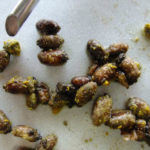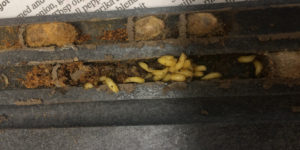Things you might see while harvesting and cleaning cocoons
Cleaning cocoons and freeing them from pests is like any gardening adventure. Keep pests low and you will have a great harvest.
Pollen lump amongst cocoons.
These are cocoons harvested from nesting tunnels and placed in water just prior to washing.. Cocoons are still covered with various debris. At the top left hand corner of this picture is the tip of a Beediverse scoop. It is pointing to a pollen lump. A pollen lump found in a nesting tunnel means that the bee larvae died and did not consume the complete pollen lump. This most often happens when a period of cold weather makes it impossible for the bee larvae to live and feed on the pollen. Various debris still adhere to cocoons.

Wriggling larva.
These larvae are in the nest because earlier in the spring a fruit fly laid her eggs on top of a mason bee pollen lump. These fruit fly larvae eat the pollen and leave nothing for the developing bee larva. This new species of fruit fly has been on the west coast of NA for more than 5 years now. Removing these pests will remove potential pests from next year’s nest.

Healthy cocoons
Here are two rows of healthy looking cocoons. But look closely, they are lightly covered by tiny pollen eating mites (white specs). Pollen eating mites feed on pollen lumps left behind for the bee larva. These pollen mites feed on the pollen and leave nothing for the bee. In the lower right hand corner is a cell fully loaded with mites. Mites are always present and can be a real problem for bees if these are not removed every year. Mites can easily be washed off under running water while rolling cocoons in a sieve.

.
.
